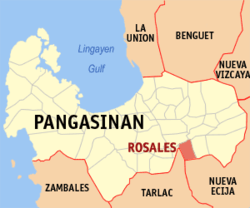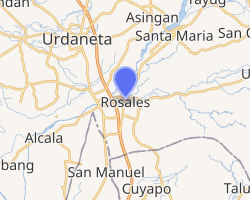Rosales, Pangasinan
Rosales, officially the Municipality of Rosales (Pangasinan: Baley na Rosales; Ilocano: Ili ti Rosales; Tagalog: Bayan ng Rosales), is a 1st class municipality in the province of Pangasinan, Philippines. According to the 2015 census, it has a population of 63,081 people.[3]
Rosales | |
|---|---|
| Municipality of Rosales | |
Robert Estrella Stadium | |
 Seal | |
 Map of Pangasinan with Rosales highlighted | |
OpenStreetMap 
| |
.svg.png) Rosales Location within the Philippines | |
| Coordinates: 15°53′40″N 120°37′58″E | |
| Country | |
| Region | Ilocos Region (Region I) |
| Province | Pangasinan |
| District | 6th district |
| Founded | March 16, 1852 |
| Barangays | 37 (see Barangays) |
| Government | |
| • Type | Sangguniang Bayan |
| • Mayor | Susan P. Casareno |
| • Vice Mayor | Enrique S. Cosue Jr. |
| • Congressman | Tyrone D. Agabas |
| • Electorate | 45,607 voters (2019) |
| Area | |
| • Total | 66.39 km2 (25.63 sq mi) |
| Population (2015 census)[3] | |
| • Total | 63,081 |
| • Density | 950/km2 (2,500/sq mi) |
| • Households | 14,365 |
| Economy | |
| • Income class | 1st municipal income class |
| • Poverty incidence | 13.3% (2015)[4] |
| • Revenue (₱) | 185,256,501.82 (2016) |
| Time zone | UTC+8 (PST) |
| ZIP code | 2441 |
| PSGC | |
| IDD : area code | +63 (0)75 |
| Climate type | tropical monsoon climate |
| Native languages | Pangasinan Ilocano Tagalog |
| Website | www |
It is sometimes called as Carmen, based on its prominent barangay of the same name (now split into two barangays). Rosales was created as a separate municipality through a Royal Decree in 1852. It was named in honor of Don Antonio Rosales.
Philippine National Author and internationally renowned novelist Francisco Sionil Josè has set a monument to the town he grew up in with his five-novels-series The Rosales Saga. The town itself is dotted with ancestral houses and heritage structures deemed as important cultural sites via the National Cultural Heritage Act.
Rosales is a junction town for those travelling between the provinces of Tarlac and Nueva Ecija to the other towns of Pangasinan. It is accessible via the NLEX (North Luzon Expressway) and TPLEX (Tarlac-Pangasinan-La Union Expressway), or via the MacArthur Highway.
Etymology
It is widely believed that the name Rosales came from the word rosal which is a name of a flower that was known to be abundant in the area. However, Spanish records revealed that Rosales was originally a ranchera founded by a pioneering Filipino named Nicolas Bañez. It was declared a pueblo in 1852. The place was named in honor of Don Antonio Rosales Liberal, a man noted for his rectitude, industry, and learning. He is also an Order of the Royal Audiencia in Manila and a Consejero de Filipinas en el Ministro de Ultramar (Secretary of Foreign Affairs) during that time.
Geography
Rosales is 171 kilometres (106 mi) from Manila and is 55 kilometres (34 mi) from the provincial capital, Lingayen.
Barangays
Rosales is politically subdivided into 37 barangays.
- Acop
- Bakitbakit
- Balincanaway
- Cabalaoangan Norte
- Cabalaoangan Sur
- Camangaan
- Capitan Tomas
- Carmay West
- Carmen East
- Carmen West
- Casanicolasan
- Coliling
- Calanutan (Don Felix Coloma)
- Guiling
- Palakipak
- Pangaoan
- Rabago
- Rizal
- Salvacion
- San Antonio
- San Bartolome
- San Isidro
- San Luis
- San Pedro East
- San Pedro West
- San Vicente
- San Angel
- Station District
- Tumana East
- Tumana West
- Zone I (Poblacion)
- Zone IV (Poblacion)
- Carmay East
- Don Antonio Village
- Zone II (Poblacion)
- Zone III (Poblacion)
- Zone V (Poblacion)
Climate
| Climate data for Rosales, Pangasinan | |||||||||||||
|---|---|---|---|---|---|---|---|---|---|---|---|---|---|
| Month | Jan | Feb | Mar | Apr | May | Jun | Jul | Aug | Sep | Oct | Nov | Dec | Year |
| Average high °C (°F) | 29 (84) |
29 (84) |
30 (86) |
32 (90) |
33 (91) |
33 (91) |
33 (91) |
33 (91) |
33 (91) |
32 (90) |
31 (88) |
29 (84) |
31 (88) |
| Average low °C (°F) | 21 (70) |
21 (70) |
22 (72) |
23 (73) |
24 (75) |
24 (75) |
24 (75) |
24 (75) |
23 (73) |
23 (73) |
22 (72) |
21 (70) |
23 (73) |
| Average precipitation mm (inches) | 127.5 (5.02) |
115.8 (4.56) |
129.7 (5.11) |
141.1 (5.56) |
248.2 (9.77) |
165 (6.5) |
185.3 (7.30) |
161.9 (6.37) |
221.4 (8.72) |
299.5 (11.79) |
199 (7.8) |
188.7 (7.43) |
2,183.1 (85.93) |
| Average rainy days | 17 | 17 | 17 | 15 | 20 | 19 | 19 | 20 | 21 | 20 | 17 | 19 | 221 |
| Source: World Weather Online[5] | |||||||||||||
Demographics
|
| ||||||||||||||||||||||||||||||||||||||||||||||||
| Source: Philippine Statistics Authority[3][6][7][8] | |||||||||||||||||||||||||||||||||||||||||||||||||
Economy
Livelihood and products:
- Chopping Board Industry (Acop)
- Charcoal (Acop)
- Tupig & Tinapa (Smoked Fish) (Carmen)
- Patupat (Balincanaway)
- Rice/Palay Producer
Local government
Like other towns in the Philippines, Rosales is governed by a mayor and vice mayor who are elected to three-year terms. The mayor is the executive head and leads the town's departments in executing the ordinances and improving public services. The vice mayor heads a legislative council (Sangguniang Bayan) consisting of councilors from the barangays or barrios.
Presidencia
The Presidencia (Town hall) is located in front of the Robert B. Estrella Stadium, Poblacion. In 1924, the construction of the Presidencia building (Municipal Town Hall) was completed and became the seat of the municipal government. The heritage building was renovated in 2004-2007 under the administration of Mayor Ricardo V. Revita with his Revitalize Rosales banner.
Landmarks
- Robert B. Estrella Stadium
- Ramon Magsaysay Monument
- Tomb of The Unknown Soldiers
- Presidencia
Nature and Adventure
- Acop Dam
- Salvacion and San Miguel Dam
- Acop Cold Springs and Waterfall
- Rosales Aviary/Mini Zoo
- Eco-Tourism Site of Rosales
- Ibtor Challenge (Sports) Festival of Rosales
St. Anthony of Padua Parish Church
St. Anthony of Padua Parish Church is part of the Roman Catholic Diocese of Urdaneta (Roman Catholic Archdiocese of Lingayen-Dagupan), at Rosales. Through a decree of the Vicar-General of the Archbishopric Authority of Manila, the Catholic Church was restored on February 15, 1915. A modest shed-like barong-barung was built at the present site of the church. Fr. Nicasio Mabanta was the first Parish Priest.
Within 3 years, a much sturdier building with GI sheets as roofing and sawali walls was constructed. Father Antonio Salindong was assigned, with longest tenure ever, continued the improvement with construction of concrete wall and facade with the image of St. Anthony. In 1946, a strong tornado tore off the GI sheet roof of the Church. Conrado Estrella, Sr. restored the roof with donations of the residents.
During the term of Fr. Primo Garcia (1979-1986), the church was expanded in its east and west wings, the beginning of the construction of the parish center, and fencing of the whole premises. Msgr. Geronimo Marcelino begun the renovations of the Parish Rectory and completed by Fr. Diomedes Laguerta.
Our Lady of Rosales Grotto
The Grotto, which is located at Station District, is regularly visited by President Gloria Macapagal Arroyo (for spiritual atonement and guidance) and local and foreign tourists.
Ancient dugout
A centuries-old unfinished dugout, a big banca (five tons, measuring 8 by 2 by 1.5 meters), was accidentally retrieved in November 2010 by Mayor Ricardo Revita at Barangay Casanicolasan in the Lagasit River, near the Agno River.[9] It was display in front of the Presidencia or Municipal Town Hall but later remove during renovation of Presidencia (town hall).
Notable people
- Carmen Rosales - Filipino actress. 2 barangays were named after her.
- Francisco Sionil Josè - Philippine National Author and internationally renowned novelist
- Vivian Foz - Filipino actress
- Hugo Sansano Sr.- Congressman of Pangasinan 5th District, 3rd Legislative of the Philippines
- Hugo Sansano Jr. - Board member of Pangasinan
Sister Towns
Rosales currently has no legally-declared townhood/cityhood relationships, however, it has good economic and tourist ties with Guimba, Nueva Ecija and Cuyapo, Nueva Ecija.
Gallery
- Rosales: The Gateway of Pangasinan and Ilocos Region
- Lim Memorial Building
- Rosales Public Market
- The center of business at night (SM City Rosales)
- Unknown Soldier Monument
- Rizal Park
References
- "Municipality". Quezon City, Philippines: Department of the Interior and Local Government. Retrieved 31 May 2013.
- "Province: Pangasinan". PSGC Interactive. Quezon City, Philippines: Philippine Statistics Authority. Retrieved 12 November 2016.
- Census of Population (2015). "Region I (Ilocos Region)". Total Population by Province, City, Municipality and Barangay. PSA. Retrieved 20 June 2016.
- "PSA releases the 2015 Municipal and City Level Poverty Estimates". Quezon City, Philippines. Retrieved 1 January 2020.
- "Rosales, Pangasinan: Average Temperatures and Rainfall". World Weather Online. Retrieved 31 October 2015.
- Census of Population and Housing (2010). "Region I (Ilocos Region)". Total Population by Province, City, Municipality and Barangay. NSO. Retrieved 29 June 2016.
- Censuses of Population (1903–2007). "Region I (Ilocos Region)". Table 1. Population Enumerated in Various Censuses by Province/Highly Urbanized City: 1903 to 2007. NSO.
- "Province of Pangasinan". Municipality Population Data. Local Water Utilities Administration Research Division. Retrieved 17 December 2016.
- Eva Visperas (November 24, 2010). "Centuries-old wooden boat retrieved in Pangasinan". The Philippine Star. Retrieved 10 January 2013.
External links
| Wikimedia Commons has media related to Rosales, Pangasinan. |